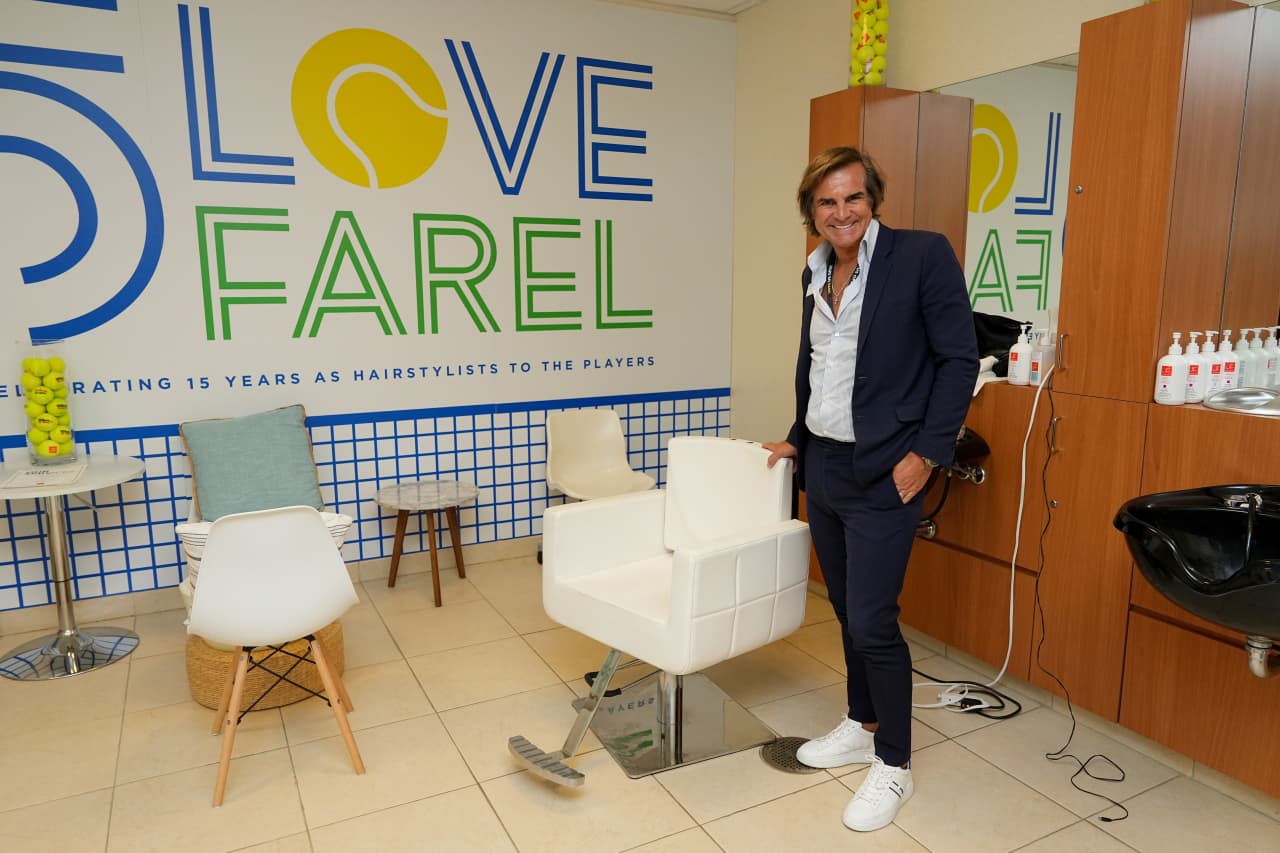Your Corporate Retreat Is On—But It’s Going To Be Weirder
Employees bond over a virtual lunar disaster or ‘80s-themed murder mystery.
At the last global sales meeting he attended before the pandemic, Jeff Chase went to Caesars Palace Las Vegas with about 60 colleagues, plus many of their spouses. In February, the biotech sales manager scouted a location for their next retreat, the Renaissance Aruba Resort & Casino, on Zoom. He never left his home in Indianapolis.
The woman organising the visit, travel entrepreneur Sarah Reuter, instructed him and 70 other attendees from the corporate world to locate sunglasses, a hairdryer and a refreshing drink in their homes. When the video panned to the Caribbean, they were asked to turn on their blow dryers to simulate a coastal breeze in their hair.
“Myself, no, I don’t have long hair, so I couldn’t do that part,” Mr Chase says. He still enjoyed the whirlwind tour enough that he’s planning to book one of Elevate Travel Co.’s virtual retreats for the company’s biannual sales meeting this fall.
Vaccines are now reaching many American workers, but some companies are in no rush to bring back the in-person off-site retreat. Instead, they’re turning to a host of increasingly elaborate virtual options, including murder mysteries staffed with actors, webcast trips to beach resorts and safaris, and purpose-built digital islands for multiday gatherings.
They’re not quite a substitute for the splashiest pre-pandemic corporate off-sites—where some participants might have slept in a castle or raced Fiat 500s around the Tuscan countryside—and usually require much less time and money. But they can still help employees bond and let off steam after months of working in unusual conditions, their participants say.
Sean Hoff, managing partner of Toronto-based corporate retreats company Moniker, says clients have started inquiring about in-person trips, but are holding off on deposits and flights until at least June. So he’s ploughing ahead creating a virtual island for an upcoming retreat of around 240 people for Webflow, a San Francisco website-design company.
Employees will participate in videogame-like team-building activities, including a boat-building race. They will inhabit customized avatars and gather in virtual locales like a “tiki hut” and a “treehouse” for small-group meetings.
“The HR team, for example, will be able to say, meet us over by the dock at 5 p.m.,” he says.
“I’m not going to lie, I was a little sceptical at first. But after a year of remote work I was so desperate to meet more of my colleagues that I just dived in,” says Allison Williams, an account manager based in St. Louis at Articulate, an e-learning software company. Articulate held a weeklong virtual retreat in early February with over 104 sessions, including virtual yoga and virtual escape rooms. Out of 291 employees across 10 time zones, 267 participated, according to a company spokesman.
Ms Williams taught a class to 45 colleagues on calligraphy and says she made a new friend, a “fellow pen nerd,” in the process. She also made new work friends through the happy hours at a virtual beach club staged on Remo, an online conferencing platform. There were various seating options, including a bar, fire pit, or surfboard-shaped table. Employees talked in small groups with whoever else gathered at each site.
Alejandra Sereleas, a vice president of accounting at the France-based videogame company Ubisoft, hired Moniker to stage a virtual, 1980s-themed murder mystery for her team of about 80 people last June.
The scenario is a wedding: The groom mysteriously drops dead after taking a sip of his drink. The participants meet eight suspects, all paid actors, and must interrogate them to solve the crime.
“We asked everyone to be in character and be creative, and sent them a wedding invitation before the event,” Ms Sereleas says. People embraced the theme, she says, donning side ponytails and chunky jewellery and setting ’80s-themed Zoom backgrounds like a Pac-Man maze.
After the murder mystery, which made its debut last May as Moniker’s first virtual offering, the company created a “lunar outpost disaster scenario” set in 2037. It was adapted from a NASA training exercise for aspiring astronauts. Participants act as mission control for a crew of colleagues whose exploratory trip to the moon’s surface has gone awry.
“We’ve kissed the Blarney stone in Ireland, had whiskey at the top of a mountain in Patagonia, rode on a dogsled in Finland, sailed a yacht off Cannes and hung out with a gorilla doctor in Rwanda,” says Liz Lathan, Austin, Texas-based CEO of Haute Dokimazo, an events company that pivoted to virtual experiences during the pandemic. Her corporate clients Zoomed with travel guides in 28 countries between last May and December.
Vanessa Blackburn, Cleveland-based enterprise retail strategist at Retail Zipline, a communications startup for retail stores, has already done two virtual retreats with her team. Their last off-site, planned before the pandemic, was to take place in Lake Tahoe, and Ms Blackburn hoped to tack on a few extra days to ski. Her company’s two-day virtual retreat in March struck a different tone.
Instead of lavish catered meals, employees got to spend $25 on their corporate card to order coffee and lunch delivery. And the goody bags sent to their homes included a tub of slime, a plastic Slinky toy and a colouring book—not for the workers themselves, but to occupy the young children that many still had at home. “My daughter loved that,” Ms Blackburn says.
 Copyright 2020, Dow Jones & Company, Inc. All Rights Reserved Worldwide. LEARN MORE
Copyright 2020, Dow Jones & Company, Inc. All Rights Reserved Worldwide. LEARN MORE
This stylish family home combines a classic palette and finishes with a flexible floorplan
Just 55 minutes from Sydney, make this your creative getaway located in the majestic Hawkesbury region.
The remote northern island wants more visitors: ‘It’s the rumbling before the herd is coming,’ one hotel manager says
As European hot spots become overcrowded , travellers are digging deeper to find those less-populated but still brag-worthy locations. Greenland, moving up the list, is bracing for its new popularity.
Aria Varasteh has been to 69 countries, including almost all of Europe. He now wants to visit more remote places and avoid spots swarmed by tourists—starting with Greenland.
“I want a taste of something different,” said the 34-year-old founder of a consulting firm serving clients in the Washington, D.C., area.
He originally planned to go to Nuuk, the island’s capital, this fall via out-of-the-way connections, given there wasn’t a nonstop flight from the U.S. But this month United Airlines announced a nonstop, four-hour flight from Newark Liberty International Airport in New Jersey to Nuuk. The route, beginning next summer, is a first for a U.S. airline, according to Greenland tourism officials.
It marks a significant milestone in the territory’s push for more international visitors. Airlines ran flights with a combined 55,000 seats to Greenland from April to August of this year, says Jens Lauridsen, chief executive officer of Greenland Airports. That figure will nearly double next year in the same period, he says, to about 105,000 seats.
The possible coming surge of travellers also presents a challenge for a vast island of 56,000 people as nearby destinations from Iceland to Spain grapple with the consequences of over tourism.
Greenlandic officials say they have watched closely and made deliberate efforts to slowly scale up their plans for visitors. An investment north of $700 million will yield three new airports, the first of which will open next month in Nuuk.
“It’s the rumbling before the herd is coming,” says Mads Mitchell, general manager of Hotel Nordbo, a 67-room property in Nuuk. The owner of his property is considering adding 50 more rooms to meet demand in the coming years.
Mitchell has recently met with travel agents from Brooklyn, N.Y., South Korea and China. He says he welcomes new tourists, but fears tourism will grow too quickly.
“Like in Barcelona, you get tired of tourists, because it’s too much and it pushes out the locals, that is my concern,” he says. “So it’s finding this balance of like showing the love for Greenland and showing the amazing possibilities, but not getting too much too fast.”
Greenland’s buildup
Greenland is an autonomous territory of Denmark more than three times the size of Texas. Tourists travel by boat or small aircraft when venturing to different regions—virtually no roads connect towns or settlements.
Greenland decided to invest in airport infrastructure in 2018 as part of an effort to expand tourism and its role in the economy, which is largely dependent on fishing and subsidies from Denmark. In the coming years, airports in Ilulissat and Qaqortoq, areas known for their scenic fjords, will open.
One narrow-body flight, like what United plans, will generate $200,000 in spending, including hotels, tours and other purchases, Lauridsen says. He calls it a “very significant economic impact.”
In 2023, foreign tourism brought a total of over $270 million to Greenland’s economy, according to Visit Greenland, the tourism and marketing arm owned by the government. Expedition cruises visit the territory, as well as adventure tours.
United will fly twice weekly to Nuuk on its 737 MAX 8, which will seat 166 passengers, starting in June .
“We look for new destinations, we look for hot destinations and destinations, most importantly, we can make money in,” Andrew Nocella , United’s chief commercial officer, said in the company’s earnings call earlier in October.
On the runway
Greenland has looked to nearby Iceland to learn from its experiences with tourism, says Air Greenland Group CEO Jacob Nitter Sørensen. Tiny Iceland still has about seven times the population of its western neighbour.
Nuuk’s new airport will become the new trans-Atlantic hub for Air Greenland, the national carrier. It flies to 14 airports and 46 heliports across the territory.
“Of course, there are discussions about avoiding mass tourism. But right now, I think there is a natural limit in terms of the receiving capacity,” Nitter says.
Air Greenland doesn’t fly nonstop from the U.S. because there isn’t currently enough space to accommodate all travellers in hotels, Nitter says. Air Greenland is building a new hotel in Ilulissat to increase capacity when the airport opens.
Nuuk has just over 550 hotel rooms, according to government documents. A tourism analysis published by Visit Greenland predicts there could be a shortage in rooms beginning in 2027. Most U.S. visitors will stay four to 10 nights, according to traveler sentiment data from Visit Greenland.
As travel picks up, visitors should expect more changes. Officials expect to pass new legislation that would further regulate tourism in time for the 2025 season. Rules on zoning would give local communities the power to limit tourism when needed, says Naaja H. Nathanielsen, minister for business, trade, raw materials, justice and gender equality.
Areas in a so-called red zone would ban tour operators. In northern Greenland, traditional hunting takes place at certain times of year and requires silence, which doesn’t work with cruise ships coming in, Nathanielsen says.
Part of the proposal would require tour operators to be locally based to ensure they pay taxes in Greenland and so that tourists receive local knowledge of the culture. Nathanielsen also plans to introduce a proposal to govern cruise tourism to ensure more travelers stay and eat locally, rather than just walk around for a few hours and grab a cup of coffee, she says.
Public sentiment has remained in favour of tourism as visitor arrivals have increased, Nathanielsen says.
—Roshan Fernandez contributed to this article.
This stylish family home combines a classic palette and finishes with a flexible floorplan
Just 55 minutes from Sydney, make this your creative getaway located in the majestic Hawkesbury region.






















